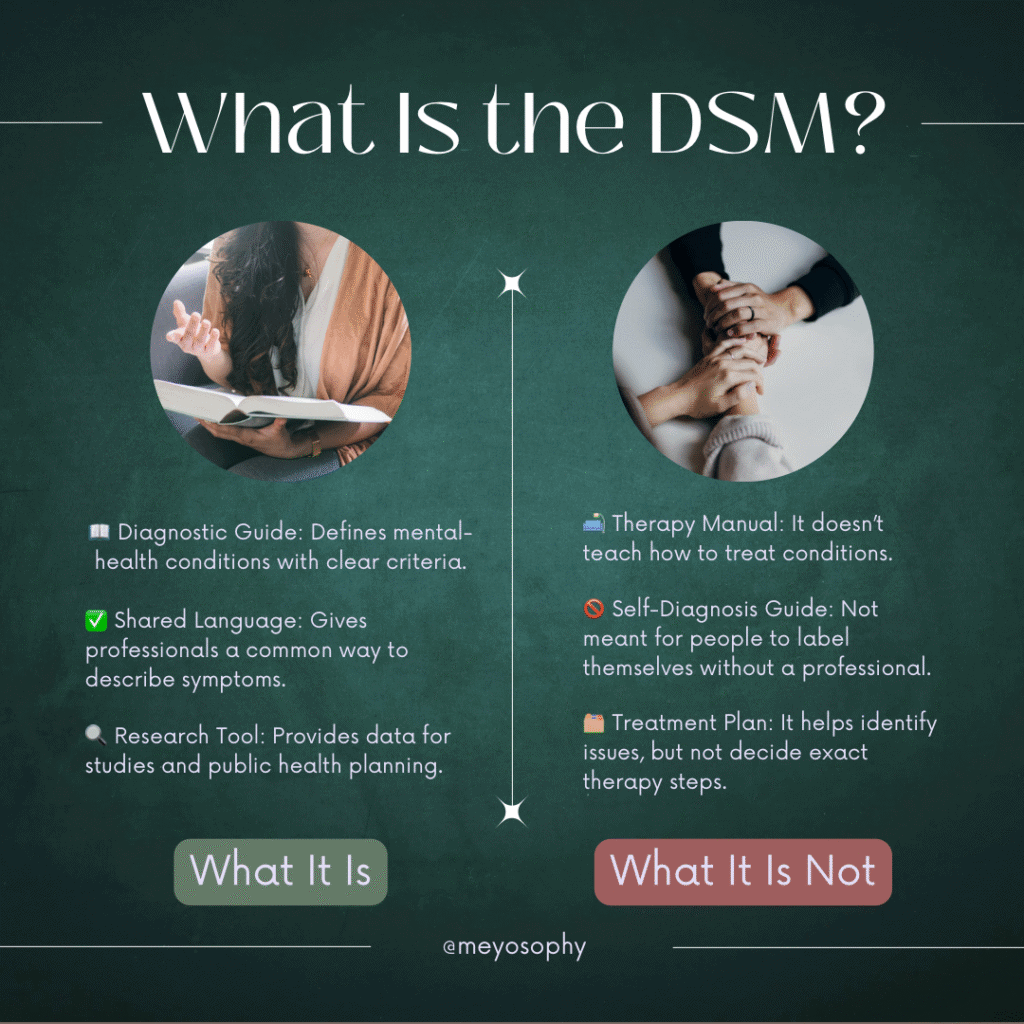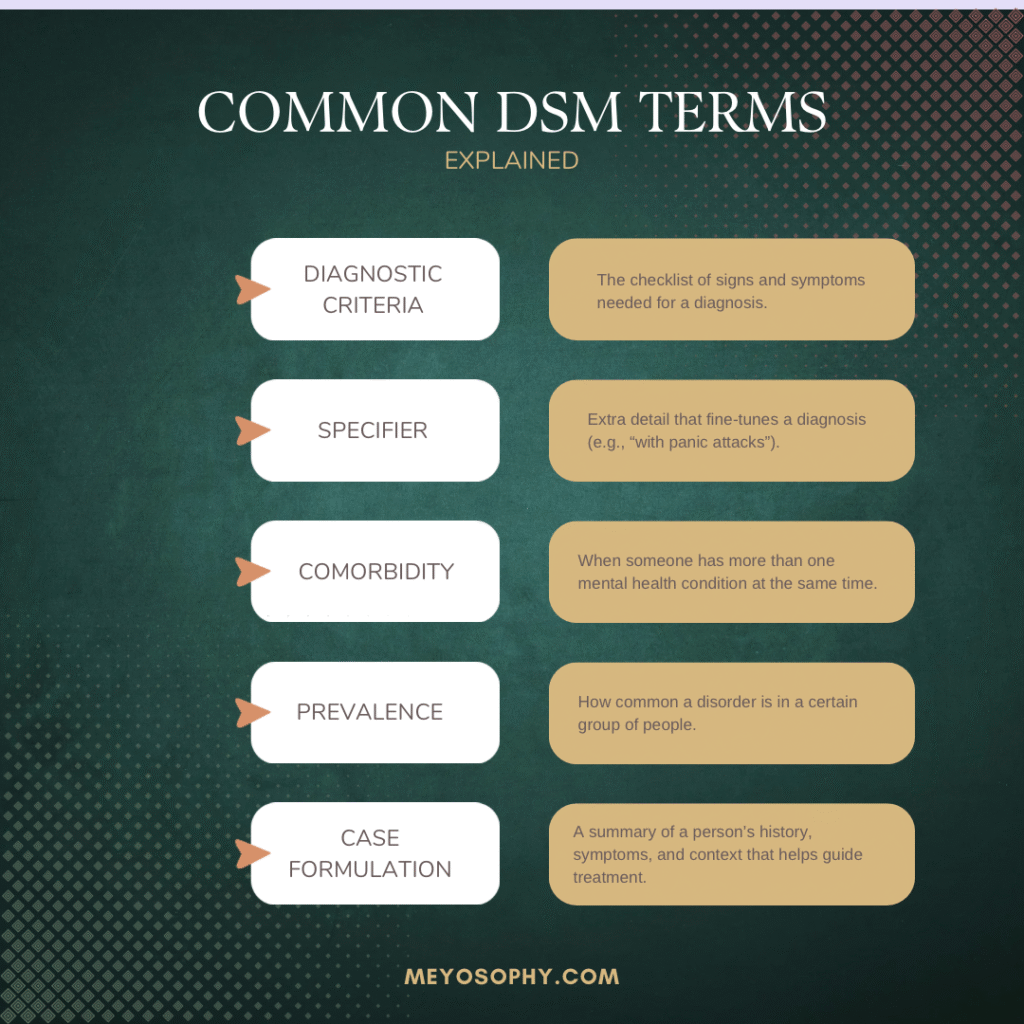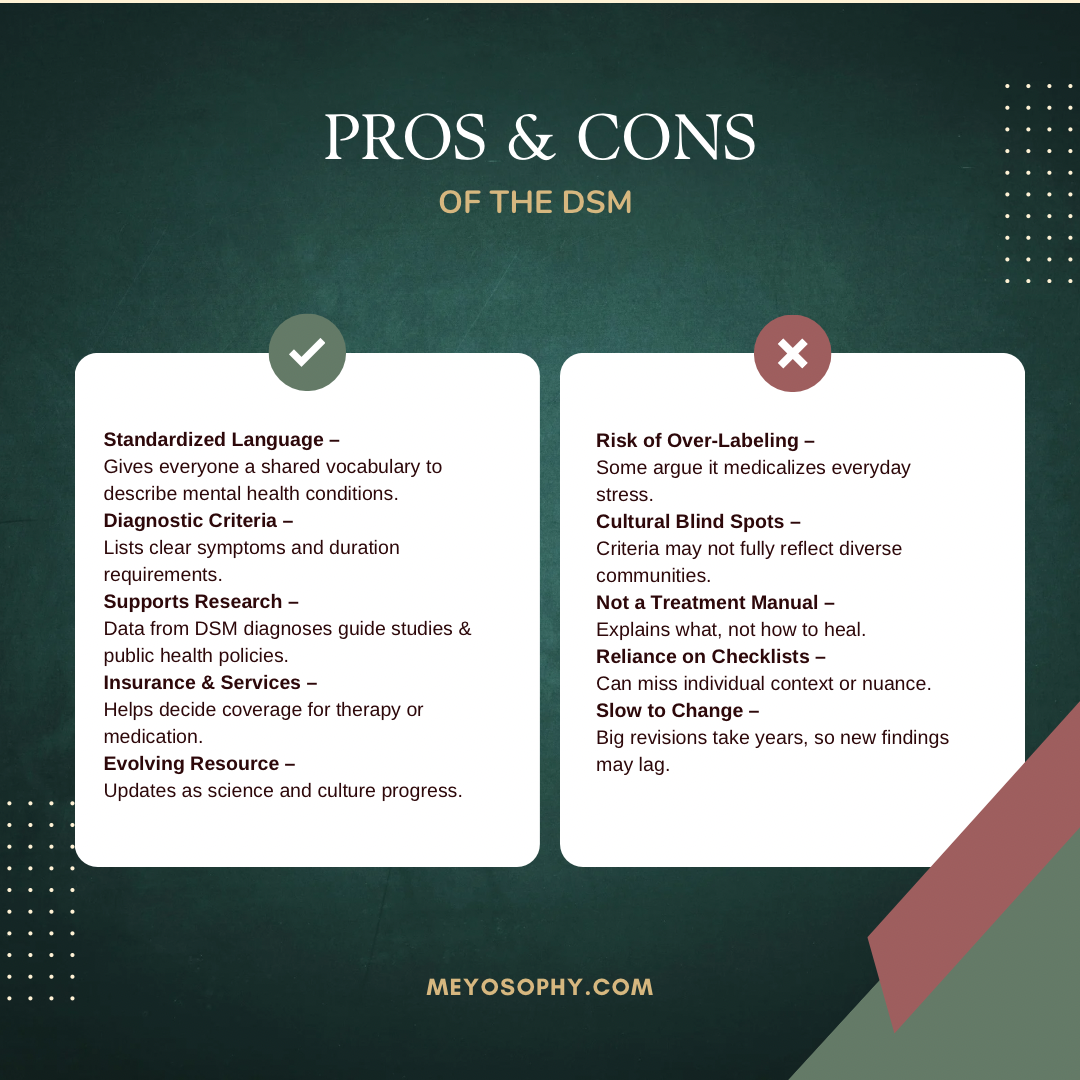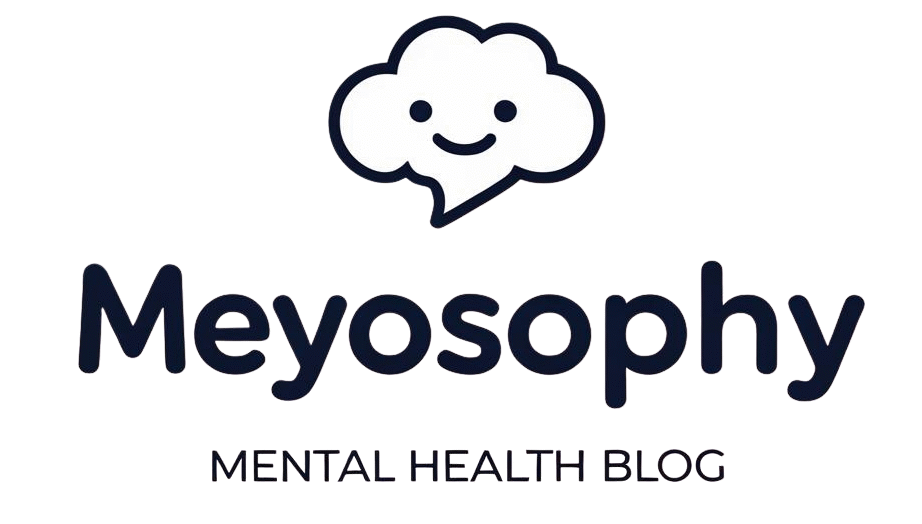A Deep Dive into the Mental Health Manual You’ve Heard About
Disclaimer: I’m not a mental health professional, everything here is shared from research and personal experience. If you’re feeling overwhelmed or need support, please consider talking to a qualified professional. You’re not alone. If you’re in the U.S., you can call or text 988 anytime. For help in other countries, visit https://findahelpline.com.
If you’ve ever wondered what professionals mean when they refer to the DSM, or seen it mentioned and thought, “Is this relevant to me?”, this article is for you. The DSM (Diagnostic and Statistical Manual of Mental Disorders) shapes how clinicians diagnose, how research is done and how we think about mental health.
What is the DSM
- The DSM is a handbook published by the American Psychiatric Association (APA).
- It lists mental health conditions (disorders), describes their symptoms, explains how long symptoms must last and includes diagnostic guidelines.
- It’s used by psychiatrists, psychologists, therapists, and in many places, insurers or public health systems, to agree on what it means to say “this person meets criteria for X disorder” [1][2].
But: the DSM does not tell you how to treat someone. It doesn’t say what therapy to use or what medication. It helps people identify what is going on first.

A brief history of how it evolved
Knowing the history helps understand why the DSM is the way it is now:
- DSM-I (1952): Very brief, general descriptions. Its main goal was classification, just naming what clinicians were seeing [2].
- DSM-II (1968): More disorders listed, but still with broad descriptions. Many professionals felt criteria were vague [2].
- DSM-III (1980): First big change. More research-based, precise definitions, symptom-based criteria. Introduced structured diagnosis [2].
- DSM-IV / DSM-IV-TR: Increased reliability, aligned more with the international system (ICD), made more categories clearer [2].
- DSM-5 (2013): Removed the “multiaxial” system, regrouped disorders, clarified diagnostic categories [4]. Older versions divided issues into “axes” DSM-5 no longer uses this, but you may still see it mentioned.
- DSM-5-TR (2022): Updated text, clarified many criteria, added new codes and new disorders; placed more focus on culture, equity, and clarity [1][5][6].
DSM-5-TR: What’s new or different?
The TR stands for Text Revision. This version keeps most of DSM-5’s structure but makes important updates [1][5].
Key changes:
- New diagnoses: Prolonged Grief Disorder is now formally included among trauma/stressor-related disorders [1][6].
- Updated diagnostic criteria: More than 70 disorders received clarifications or little changes in wording [1][5]. Criteria for dementia vs. neurocognitive disorders, mood disorders, autism, delirium, and more were revised for clarity [1].
- Cultural & identity updates: Language is more inclusive and less stigmatizing (e.g., “experienced gender” instead of “desired gender”) [1][3]. Expanded notes on race, discrimination and how culture can affect symptoms [3].
- Coding & self-harm tracking: New ICD-10-CM codes for suicidal behavior and non-suicidal self-injury [1]. Added an option to code “no diagnosis or condition” so clinicians can record an evaluation without assigning a disorder [1].
How professionals use the DSM in real life
- During a diagnostic interview, a clinician compares a person’s symptoms, duration and distress with DSM criteria.
- They might also use questionnaires or screening tools that align with DSM guidelines.
- Diagnoses help with treatment planning: knowing if someone meets criteria for major depressive disorder vs. generalized anxiety disorder can guide therapy or medication decisions.
- DSM diagnoses align with ICD codes, which matter for insurance or medical records [2][4].
- Researchers use DSM definitions to study prevalence, compare treatments and track trends.

Why the DSM matters and what it’s good for
- Consistency & shared language: Without a system like the DSM, professionals might use really different labels for the same symptoms.
- Reliability: Clear criteria mean two clinicians are more likely to agree on a diagnosis.
- Research & public health: Standard definitions make studies and statistics more accurate.
- Regular updates: Revisions like the DSM-5-TR show the field is evolving with research, culture and patient feedback [1][3][5].
Criticisms and limitations
- Pathologizing normal reactions: Some say DSM risks labeling everyday sadness or stress as illness.
- Symptom overlap: Many disorders share signs (e.g., anxiety, sleep issues). Comorbidity can complicate diagnosis.
- Cultural fit: How people express distress differs by culture. DSM-5-TR improved here, but gaps stay [3].
- Validity vs. reliability: DSM ensures consistency but some categories may not map correctly to biological causes.
- Stigma risk: Labels can help access help but may feel limiting to the one receiving the label.
- Changing editions: Shifts between versions can confuse patients or insurers.

Who the DSM is for and when to be cautious
Useful for:
- Clinicians diagnosing and planning treatment
- Researchers and students
- Mental health advocates or anyone wanting to understand how diagnoses are made
Less helpful or risky:
- Self-diagnosing without professional input
- Treating a diagnosis as your whole identity
- Assuming DSM criteria fit every culture or context
FAQs
ICD covers all diseases globally; DSM focuses on mental disorders, but aligns codes for compatibility [2].
No. It defines disorders; treatment decisions depend on guidelines and individual needs.
It was removed in DSM-5 and remains out in DSM-5-TR [4].
Mostly similar but: adds clarity, a few new diagnoses and more inclusive language [1][6].
Final thoughts
When I first came across the DSM, it felt intimidating. Like a giant rulebook only experts could understand. Over time, I realized it’s really just a shared language for talking about experiences many of us go through. I’ve seen how having a clear diagnosis can lift a huge weight off someone’s shoulders: suddenly there’s a name for what’s been happening and that means there are tools and support to help. At the same time, I remind myself that no manual can capture the whole of a person. We’re always more than the words on a page. The DSM is just one guide among many on the path to understanding and healing mental health/ ourselves.
Disclosure: This post contains Amazon affiliate links. That means if you click and make a purchase, I may earn a small commission at no extra cost to you. I only recommend products I truly believe in. Thank you for supporting this blog and helping me keep the content free and helpful! 💛
Want to buy the DSM handbook? You can do that here.
Sources
- American Psychiatric Association. DSM-5-TR: Rationale, Process, and Overview of Changes. Psychiatric Services, 2022.
- National Board for Certified Counselors. DSM-5 Overview.
- Verywell Mind. What to Know About the DSM-5-TR Changes.
- Cleveland Clinic. DSM-5: What It Is & What It Diagnoses.
- American Psychiatric Association. Facts About DSM-5-TR.
- Counseling Today. What’s New with the DSM-5-TR?

